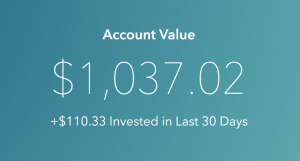 Apparently millennials aren't saving enough for the future, but a collection of brand new apps targeted towards this market segment could be changing that.
Apparently millennials aren't saving enough for the future, but a collection of brand new apps targeted towards this market segment could be changing that.
I've been conducting my own micro-investing experiments for the past year, and although some people (usually the old farts) seem to think it's a waste of time, my own micro-investments have grown around 10% over the past year. Which is as much, or more than their investments. So while the old farts are refusing to adapt and change, we can embrace new technologies and start investing more.
What is Micro Investing
Micro investing is saving very small amounts on a regular basis. Traditional investments such as stock purchases via a broker or a term deposit, require large amounts of capital and your money is often locked away for long periods of time. Micro investing allows anyone to with as little as $5 to get started and your money is available on demand.
The Advantages of Micro Investing
Lower Barrier to Entry – You don't need large assets and a lot of capital to invest. You can get started with small amounts of capital, which add up over time.
Automated – The best micro investment apps are automated. They will deduct small amounts from your debit card or bank account and automatically transfer them to the investment account. For the most part, you don't even realise you're saving.
Easy to Use – Banking and financial apps have a history of being really hard to use, full of jargon and ugly. The new generation of micro investing apps are beautiful and simple to use. Gone are the days of horrible bank websites.
What to Look out for
Fees – Apps like Acorns charge monthly fees to cover the transaction costs. Acorns charges $1 per month. Accounts with a small balance may find that fees eat into their profits. But once your investment account grows above $100 this will start becoming less of an issue. I've found the growth to so far out weigh the fees by a long way.
Where to Micro Invest
Acorns is probably the most well known micro investing app. The app connects with your bank account to track your purchases. It then rounds up these purchases to the nearest dollar and transfers the roundup amount to an investment account. This means that you're investing every time you spend money. Your money is invested in various ETFs and Bonds and you can choose how aggressive you want your account to be. Acorns charges $1 per month in fees and is available in the U.S and Australia.
Betterment is a no minimum investment platform. Although Betterment doesn't auto-invest in the same way that acorns does, you can setup automatic deposits. The fees depend on how large your account is, but you'll be paying around 0.35%.
Robin Hood is a stock investing app that doesn't charge brokerage fees. This means you can invest smaller amounts of capital into stocks. Of course you still need to pick your own stocks. This will put many people off, but if you are looking to regularly invest in stocks and believe that you can pick the right ones to invest in, this is a good micro investing option for you.
Stash allows you to invest in things that you believe in such as technology or clean energy. It groups together a portfolio of stocks based on your interests and allows you to invest from as little as $5. You can then auto-invest money on a regular basis. They charge a $1 per month to manage your account.
These are just some of the apps that are available. New ones are popping up all the time. This really is an exciting time to be an investor. There are so many different choices that cater from people who want to just set and forget to those who want to take an active role in their investments. And best of all, anyone can get started! All you need is $5 and a phone.
What are your favorite micro-investing apps? Have you found them to be profitable? Let me know in the comments.

